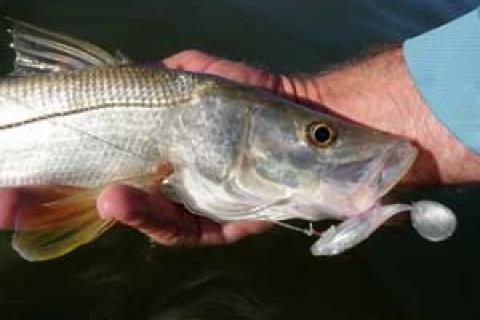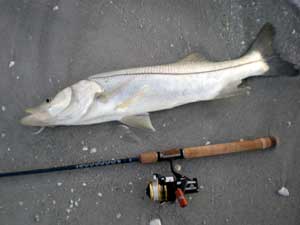
Snook (centropomus undecimalus) are generally found along the structure of inshore brackish ecologies. Because of its temperature tolerance range and tropical/Central/South American origins, "USA snook" are only found in quite fishable numbers in Florida. And even in Florida, it's only that part of the state which is basically south of a horizontal line drawn through Orlando.
 |
| Spawning season for the Florida snook is high summer — beginning in May lasting through late summer or early fall. |
Though we are often taught that snook are like largemouth bass in their love of hidey-hole structure for ambush purposes — be it mangroves, dock pilings or bridges — this is not always the case. And the timing for those "exceptional" movements is when snook move to the inlets and passes of Florida to spawn. These will be the times when snook move along the adjacent beaches on the prowl for food, such as minnows, white bait or even small turtle hatchlings. The beauty of these movements is that the snook can be found cruising barely a few feet off the water's edge, especially at high tide.
Spawning Season
The spawning season for the Florida snook is high summer. Generally, that time can begin in May and taper off with the tropical weather of late summer and early fall. So, in effect, this is a hot weather game.
The beauty of this season is that placid weather often prevails, creating clear calm water where the angler can "sight fish" in their presentations to prowling snook. On the rare summer days when the waters are turbid, anglers can still blind fish to likely pockets and runs right along the surf line. Snook fishing on the beach is a combination of hunting, flats fishing and surf fishing.
On the aforementioned rough days when sighting fish is unlikely, look for the presence of any dimpling bait, blow-ups or game fish swirls under bait or diving birds along the beach. In these situations when the water is turbid, consider switching to a more visible white bucktail jig, perhaps scent-enhanced with a few drops of attractant. Cast to as many likely looking current "runs," sandbar breaks, contours and pockets along the beach. Generally you'll find blind casting the beaches more effective by retrieving your lure parallel to the shoreline with the lure being worked with the current, like a disoriented bait fish.
It's my position that sight casting to cruising snook in clear water off the beaches is a more complex, challenging and rewarding enterprise than blind fishing the beach, and there are definite parameters for this specialty. Try to realize that you are basically "bonefishing" for snook. This means you have to sight the snook before it sees you so the fish is not alarmed or spooks away before your presentation. This also demands that you minimize your profile and rod movements to stay "stealthy."
Because you strive for the sun at your back to best spot the fish — i.e., Florida's west coast in the morning — you want to minimize your shadow so as not to spook your sighted cruising snook. I often make my casts to close-by fish literally lying on my stomach. Obviously, one can only do this with spinning tackle, with fly tackle reserved for standing presentations.
On the subject of stealth with these clear water days, you'll want to use only fluorocarbon leader material and the lightest pound test possible. With snook, 30-pound leader material is the thinnest diameter without risking a huge jump in cutoffs. I also advocate the use of monofilament line for spinning tackle and clear fly lines for the most natural look. For beach snooking, less, then, is more. Strive for simplicity and stealth again and again.
 |
| Always follow the rule to use the smallest lure or fly possible — this way, any size snook can eat it. |
Regarding actual tackle choices, spin, plug or fly are all fine. Since the size range of beach snook often tops out around 7 pounds, it is important to understand that hooking a big female fish of over 15-20 pounds is still a possibility. This means that your reels' line capacity should have at least 150 yards on it. I walk the beach with two spinners — one, a 6-pound outfit and the other, a 10-pound outfit. The choice of which outfit I cast will depend on the size of the fish I've sighted. My biggest career beach-caught snook was just under 20 pounds and caught on Sanibel Island, Fla. And, yes, I caught it on my heavier spinner.
Locale
As to locale and technique, the best beaches are the ones that have the least pressured fish, either by boats, swimmers or other anglers. As a practical matter, this means fishing Florida's (East) Gold Coast beaches on calm days before the lifeguards and crowds arrive. Across the state in the Gulf of Mexico, Florida's west coast from Sarasota south to Marco Island has the most snook on the beach. You can fish there for snook that will literally cruise under swimmers- such as Naples beaches- but these snook are understandably reluctant strikers. Try to get to beaches only reached by boat, such as Keywadden Island, south of Naples. The fish here are less pressured and far more likely to strike. Just anchor your boat off the beach, get out, and prowl the surfs' edge for cruising snook on foot.
In this kind of sight fishing, in order to see the snook before it sees you, you need to spot the fish fast and optimally. The best way to do this is by donning amber-colored polarized sunglasses and wearing a fishing cap with a peak featuring a dark underside. This combo will help your vision to penetrate the shallows in the low light periods of dusk and dawn.
The next most important way to spot your fish is by having the sun at your back, except obviously at high noon, when the sun is directly overhead. On Florida's west coat, this means walking the beach and casting from it in the mornings. In the late afternoons as the sun sinks into the west, try getting into the Gulf and walking out about 40 feet and begin your stalk looking eastward, back at the beach from the water itself. Even in such shallow water, it's best to have the sun at your back for sighting the smaller snook, which can be surprisingly tough early and late in the day.
Additional Things to Consider
Three more essential factors are water height, "leading" the fish and matching the hatch.
In order for snook to cruise the beach, there must be enough water for them to swim in. Generally, this is best on the high tide when they can prowl at the surf's edge. The best timing is to get a rising tide when the snook "know" they can edge right to the beach as the water goes higher. I've actually caught them cruising with their dorsal and tail fins partially out of the water on a rising tide. The worst time to pursue them on the beach edge is on an extreme (full moon or new moon) low tide.
Since your snook will be cruising, be sure you lead the fish and not land your offering in its face, which is sure to spook it, since food does not attack the predator. A good rule of thumb is to land your lure quietly about 4 feet in front of the snook and slowly work it when the snook is a yard away. In extremely calm conditions, lead the fish by 6 feet and activate your lure when the fish can see it.
Always be sure to use a lure or fly that looks like what the snook may be feeding on. The best choice is often anything that resembles a minnow or small silvery sardine or pilchard. I remember one day when I found the snook pursuing baby turtles, and I immediately switched over to a brown plastic crab which came close to matching the hatch. They found this lure irresistible. Always follow the rule to use the smallest lure or fly possible. This way, any size snook can eat it. If you oversize your offering, you are eliminating a bunch of modest-sized that could make or break your day.
- 22208 views

